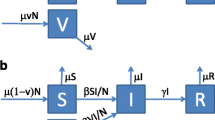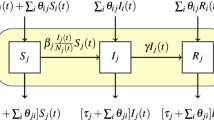Abstract
Objective
To evaluate the economic efficiency of influenza vaccination using both dynamic and static modelling approaches.
Setting
The Spanish National Health System.
Design and methods
We modelled the progress of an influenza epidemic in Spain according to the epidemiological pattern of susceptible?infective?resistant, employing a non-linear system of ordinary differential equations that enables the measurement of epidemiological effects of an anti-influenza vaccination. We used a decision tree to represent the repercussion on healthcare resources use and on financial resources. The same analyses were conducted using a static approach, and the results were compared. Healthcare costs were valued in €, year 2005 values.
Results
For the base case, the impact of the healthcare intervention (vaccination) was not efficient from the perspective of the healthcare payer when using a static approach (return rate 0.28 per € invested in vaccination). Nevertheless, it was efficient when employing a dynamic approach (return rate 1.22 per €). Furthermore, a considerable freeing of healthcare resources would have been produced over the entire influenza season.
Conclusions
The indirect effect of vaccination on the non-vaccinated individuals (the ‘herd immunity effect’) can be greater than the direct effect on individuals vaccinated. This implies that the herd immunity effect needs to be taken into consideration in the economic evaluations of prophylactic measures employed against infectious diseases.






Similar content being viewed by others
References
Soto J. Pharmacoeconomic studies: why, how, when and for what? [in Spanish]. Medifam 2001; 11 (3): 147–155
Drummond M, O’Brien BJ, Stoddart ’GL, et al. Methods for the economic evaluation of health care programmes [in Spanish]. Madrid: Díaz de Santos, 2001
Service of Evaluation of Health Technologies. Guide of economic evaluation in the sanitary sector [in Spanish]. Osteba: Vitoria-Gasteiz, 1999
Edmunds WJ, Medley GF, Nokes DJ. Evaluating the cost-effectiveness of vaccination programmes: a dynamic perspective. Stat Med 1999; 18 (23): 3263–3282
Rodrigo C. Glossary. In: Arístegui J, Corretger JM, Moraga F, et al., editors. Child vaccinations: from theory to practice [in Spanish]. Bilbao: Ciclo Editorial, 2004: 23–31
Lynd LD, Goeree R, O’Brien BJ. Antivira’ agents for influenza. Pharmacoeconomics 2005; 23 (11): 1083–1106
Sander B, Hayden FG, Gyldmark M, et al. Post-exposure influenza prophylaxis with oseltamivir. Pharmacoeconomics 2006; 24 (4): 373–386
Zill DG, Cullen MR. Differential equations with frontier values problems. 5th ed. Mexico: Thomson Learning, 2002
Blanc hard P, Devaney RL, Hall GR. Differential equations [in Spanish]. Mexico: Internacional Thomson Editores, 1999
Klein M. Mathematical methods for economics. Boston (MA): Addison-Wesley, 1998
Braun M. Differential equations and their applications [in Spanish]. Mexico: Grupo Editorial Iberoamérica, 1990
Gestal JJ. Acute respiratory infections: influenza [in Spanish]. In: Piédrola G, del Rey J, Domínguez M, et al., editors. Preventive medicine and public health. 9th ed [in Spanish]. Barcelona: Ediciones Científicas y Técnicas, 1994: 491–516
Keeling, M. The mathematics of diseases. Plus Magazine 2001; (14). Cambridge (UK): University of Cambridge, 2001 [online]. Available from URL: http://pass.maths.org.uk/issuel4/features/diseases/index-gifd.html [Accessed 2007 Oct 3]
Anderson RM, May RM. Population biology of infectious diseases: part I. Nature 1979; 280 (5721): 361–367
Anderson RM, May RM. Directly transmitted infectious diseases: control by vaccination. Science 1982; 215: 1053–1160
Thieme HR, Yang J. An endemic model with variable re-infection rate and applications to influenza. Math Biosci 2002; 180: 207–235
Lavenu A, Valleron AJ, Carrat F. Exploring cross-protection between influenza strains by an epidemiological model. Virus Res 2004; 103 (1–2): 101–105
Boni MF, Gog JR, Andreasen V, et al. Influenza drift and epidemic size: the race between generating and escaping immunity. Theor Pop Biol 2004; 65: 179–191
National Centre of Epidemiology. Epidemiologic commentary about diseases of obligatory notification and system of microbiological information [in Spanish]. Bol Epidemol Semanal 2004; 12 (10): 101–106
Gil de Gómez MJ, López MJ. Influenza in the autonomous community of La Rioja: activity of the disease and evaluation of the vaccination campaign. Recommendation of anti-influenza vaccine for the 2001–2002 season [in Spanish]. Bol Epidemiol de La Rioja 2001; 165: 1167–1171
Arrazola MP. Anti-influenza vaccination in adults. In Vaccines recommendations. Investigation Group of Madrid. Boletín 3 [in Spanish]. Madrid: Asociación para la Formación e Investigación en Salud Publica, 2004: 33–46
Pumarola T, Marcos MA, Jiménez de Anta MT. Influenza quimioprofilaxis [in Spanish]. Vacunas 2002; 3 Suppl. 1: 24–27
Kincaid D, Cheney W. Numerical analysis: the mathematics of the scientific calculus [in Spanish]. Wilmington (DE): Addison Wesley Iberoamericana, 1994
Anderson RM, May RM. Infectious diseases of humans: dynamic s and control. New York: Oxford University Press, 1999
Garcia de Codes A, Arrazola MP, de Juanes JR, et al. Anti-influenza vaccination in healthcare staff: strategies to increase the coverage in a general hospital [in Spanish]. Med Clin (Bare) 2004; 123 (14): 532–534
Martínez-Martínez F. Strategies and coverage of anti-influenza vaccination of primary care staff: retrospective study [in Spanish]. Vacunas 2004; 5 (2): 35–37
Pastor MA, Schwuarz H, Pedrera V, et al. Anti-influenza vaccination state of primary care staff [in Spanish]. Aten Primaria 2004; 33 (3): 161
Mayo E, Hernández V, Carrasco P, et al. Evolution of anti-influenza vaccination in the community of Madrid between the years 1993 and 2001 [in Spanish]. Vacunas 2005; 6 (2): 41–45
Peña A, Martínez L, Urbiztondo L. Knowledge, attitude and beliefs of the primary care staff about anti-influenza vaccine and vaccination [in Spanish]. Vacunas 2005; 6 (2): 46–50
Das Gupta R, Guest JF. A model to estimate the cost benefit of an occupational vaccination programme for influenza with Influvac® in the UK. Pharmacoeconomics 2002; 20 (7): 475–484
De Mateo S. The importance of surveillance to control and to prevent influenza [in Spanish]. Vacunas 2002; 3 Suppl. 1: 9–13
Salleras L, Domínguez A. Health and economic impact of an anti-influenza vaccination [in Spanish]. Vacunas 2002; 3 Suppl. 1: 38–46
García MA, Figueroa Y. Evaluation of an anti-influenza vaccination program in a labour setting [in Spanish]. MAPFRE Medicina 2001; 12 (1): 49–53
Nichol KL. Cost-benefit analysis of a strategy to vaccinate healthy working adults against influenza. Arch Intern Med 2001; 161 (5): 749–759
Public Health Directorate. Influenza [in Spanish]. Ministerio de Sanidad y Consumo; 2004 [online]. Available from URL: http://www.msc.es [Accessed 2007 Nov 1]
Conesa A, Vilardell L, Muñoz R, et al. Analysis and classification of hospital emergencies through Ambulatory Patient Groups [in Spanish]. Gac Sanit 2003; 17 (6): 447–452
Pradas R, Antoñanzas F, Zoellner Y. Economic evaluation of anti-influenza vaccination by the firm medical services: a health perspective [in Spanish]. Pharmacoeconomics 2005; 2 (2): 55–63
Campins M, Farjas P, González D. Pharmacoeconomic model of anti-influenza vaccination in population aged over 64 years [in Spanish]. Vacunas 2004; 4 Suppl. 1: 35–41
General Council of Pharmaceutical Official Association. Madrid: Base de datos del Medicamento, 2005
Royal Decree 1605/1980, of 31st of July, on the premium rates for unemployment, social security and salary fund, and review of the copayments for some drags [in Spanish]. Madrid: Official Bulletin of the State, number 186, 1980 Aug 4
Resolution, 2004 Aug 2, on the tarrifs for health services provided in La Rioja [in Spanish]. La Rioja: Official Bulletin of La Rioja, number 89, 2004 Aug 5
Database of unitary cost (CD Rom version) [in Spanish]. Barcelona: Soikos, 2004
Brisson M, Edmunds WJ. Economic evaluation of vaccination programs: the impact of herd-immunity. Med Decis Making 2003; 23 (1): 76–82
Trotter CL, Edmunds WJ. Reassessing the cost-effectiveness of meningococcal serogroup c conjugate (mcc) vaccines using a transmission dynamic model. Med Decis Making 2006; 26 (1): 38–47
Armstrong GL, Billah K, Rein DB, et al. The economics of routine childhood hepatitis A immunization in the United States: the impact of herd immunity. Pediatrics 2007; 119 (1): e22–e29
Haber M, Barskey A, Baughman W, et al. Herd immunity and pneumococcal conjugate vaccine: a quantitative model. Vaccine 2007; 25 (29): 5390–5398
Arrazola MP, de Juanes JR, García de Codes A. Interpandemic control of influenza [in Spanish]. Vacunas 2005; 6 (2): 56–61
Godoy P. Avian influenza pandemic: a new challenge for public health [in Spanish]. Gac Sanit 2006; 20 (1): 4–8
Sandman PM, Lanard J. Avian influenza: how to inform [in Spanish]. Perspectivas de Salud: La revista de la Organizaci6n Panamericana de la Salud 2005; 10 (2): 2–9
De Mateo S, Larrauri A, Mesonero C. Influenza surveillance: new solutions to an old problem [in Spanish]. Gac Sanit 2006; 20 (1): 67–73
Ryan J, Zoellner Y, Gradl B, et al. Establishing the health economic impact of influenza vaccination within the European Union 25 countries. Vaccine 2006; 24: 6812–6822
Batalla J, Urbiztondo M, Martínez M, et al. Incidence of adverse effects associated with systematic vaccination and vaccination programmes in Catalonia [in Spanish]. Vacunas 2003; 4 (4): 127–131
Allsup S, Gosney M, Haycox A, et al. Cost-benefit evaluation of routine influenza immunization in people 65–74 years of age. Health Tech Assess 2003; 7 (24): 1–65
Muennig PA, Khan K. Cost-effectiveness of vaccination versus treatment of influenza in healthy adolescents and adults. Clin Infect Dis 2001; 33 (11): 1879–1885
Martín JM. Analysis of a economic model about a populational anti-influenza vaccination strategy in healthy employees [in Spanish]. Rev Esp Salud Ptiblica 2006; 80 (3): 219–231
Acknowledgements
Editorial assistance was provided by Dr Peter R. Turner of t-SciMed (Reus, Spain). A previous version of the static model included in this text was developed with the support of a grant received from Solvay Pharma to study the efficiency of influenza vaccination. This current work was partially supported by a grant from the Riojan Regional Government.
Author information
Authors and Affiliations
Corresponding author
Rights and permissions
About this article
Cite this article
Pradas-Velasco, R., Antoñanzas-Villar, F. & Martínez-Zárate, M.P. Dynamic Modelling of Infectious Diseases. Pharmacoeconomics 26, 45–56 (2008). https://doi.org/10.2165/00019053-200826010-00005
Published:
Issue Date:
DOI: https://doi.org/10.2165/00019053-200826010-00005




